While anchors are often the topic of debate, the other components of the ground tackle system frequently lack attention. General purpose portable boat anchors are naturally drag embedment anchors, which is the technical way of saying they work by setting themselves in response to a horizontal pull. The more of a vertical element there is in this pull, the less chance they have of setting then holding well. Since the boat is always some vertical distance above the anchor, it is a challenge to minimize this upward pull in the interest of maximizing the anchor’s possible performance. This is where the rode enters the picture.
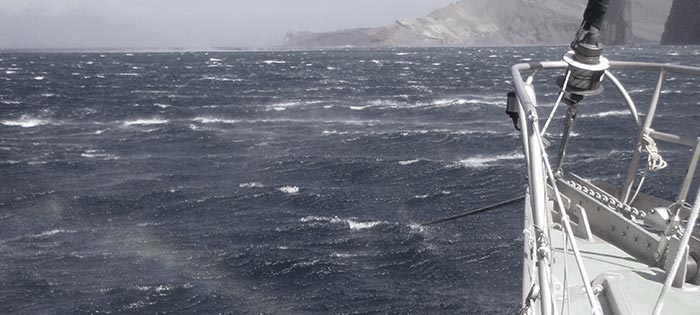
The old way of thinking: Catenary
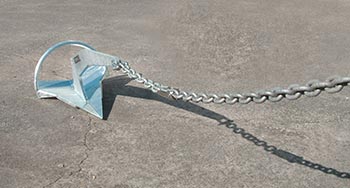
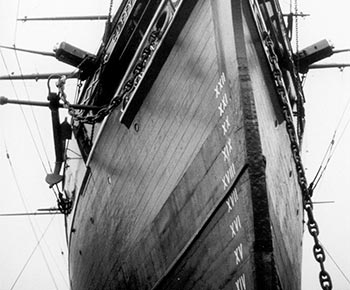
Catenary is a word which describes the mathematical nature of a certain curve, comparable with other terms such as parabola and hyperbola. While the path of a football kicked into the air is a parabola, a catenary is seen in the real world when a flexible line hangs between two points. It is the effect of gravity, a uniformly directional force, acting along its length. A typical example is the chain and rope connecting your anchor to your boat.
This catenary has the convenient effect of lowering the effective angle of pull on the anchor, which is the positive result we are striving for. Clearly, the heavier the rode, the better this effect, and the greater the pull will need to be to negate it (i.e. to pull the rode straight). Hence, the lore is to use heavy chain behind the anchor.
This way of doing things has been reinforced over thousands of years, mostly with relatively large vessels, and has built a strong tradition. Ships from all eras have used very heavy chain, and relatively small and ineffective anchors. This for the most part works well. Unfortunately, the relevant factors do not scale down evenly to smaller boats such as today’s cruising and pleasure yachts. In fact, the best way to anchor a toy boat in the garden pond is with a relatively large toy anchor and a rode consisting entirely of an elastic line. Between this extreme and that of large ships, a compromise needs to be found.
This compromise will utilize adequate scope in order to acheive the desired low angle of pull on the anchor.
Thinking small
Recognizing that a small boat is not a ship is the first step. While ships have massive inertia and waves/swells do not normally bother them, a yacht or motor-boat is subject to comparatively violent surge, and winds which are very high on a relative basis. As such the forces are relatively higher, and on the other hand small boats can carry anchors which are, for the size of boat, quite large. If a 10 m yacht carries a 15 kg anchor, this anchor scaled to fit a large container ship would simply be too massive to be practical.
It is then important to critically examine the mathematics of the catenary curve of a boat’s chain to investigate its true usefulness to a small boat. As the above “old way of thinking” is commonly adhered to, it is a widespread myth that all boats should carry as much chain as possible – and the heavier the better.
In fact, we shall see that catenary rarely offers much benefit which is truly worthwhile, and any unnecessary extra weight of the chain is often far better invested in other elements of the anchoring system.
To illustrate the true effect of catenary, computer simulations courtesy of Alain Fraysse will be employed. The graphs below give a visual picture of the profile of the anchor rode in specific circumstances.
Catenary will be given every chance to prove itself. We will imagine a 16 m (∼52′) boat, and simulate 48 m of 12 mm chain. The distance from the seabed to the roller will be 8 m (giving a scope of 6:1). Connecting theory to reality, this is in fact emulating the exact set-up of the yacht pictured in the photo at the start of this article riding out 50–60 knots in Antarctica.
Firstly however, we will examine the catenary curve as it exists in more moderate wind conditions of 20 knots:
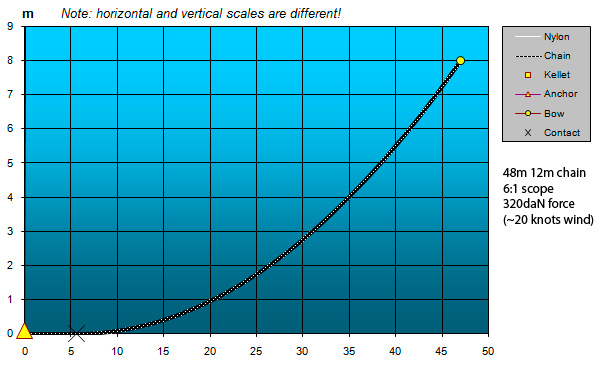
Increasing the force on the rode to simulate 50 knots wind, we see that the catenary quickly disappears, and we have the almost bar-tight rode visible in the above photo:
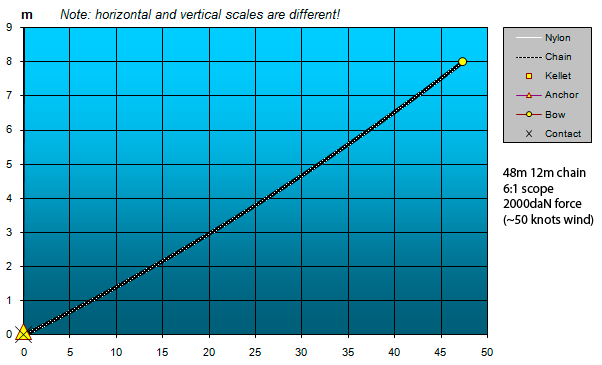
In shallower water, there is even less benefit from the catenary effect.
As demonstrated, the point is that catenary does not really provide that much benefit in strong winds. The question then is how the limits of the anchor’s performance relate to this. When the “old way of thinking” was valid, the small anchors in use would certainly always drag before the heavy chain used could straighten, catenary therefore providing a clear benefit. However, it is a different story with small boats and modern anchors. In the above photo, the Rocna 55 at the end of the rode is untroubled and has already handled stronger winds earlier in the morning. Other real world examples are commonplace; for instance, in 2006 West Marine and several magazines tested anchors around the 15 kg size, with a rode consisting of 25 mm rope with a 6 m leader of 8 mm chain. Anchors such as the Rocna resisted maximum pulls and produced “a bar-tight cable.”
We can therefore conclude that the majority of typical rode set-ups lose most of their benefit provided by catenary well before the anchor is likely to be anywhere near its limits. Beyond this point (once the rode is effectively straightened), the weight of the chain makes no difference to the ability of the anchor to hold the boat.
Conclusions in brief
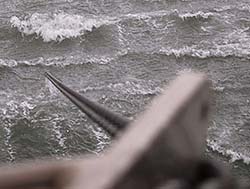
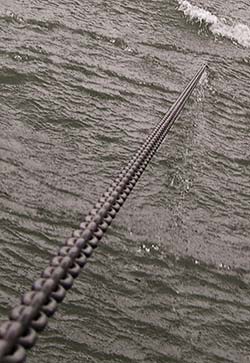
The practical upshot to this as it will interest most boaters is that the lore of heavy chain is demonstrably false as it applies to small boats and modern anchors. Chain is still necessary for a number of other reasons, but it need not be unnecessarily heavy. It follows that high strength chains may be utilized to offer the same functionality for less weight – as such, high tensile grades are recommended en lieu of G40 / high-test, and it is suggested that weak low grades such as G30 / BBB are avoided altogether.
Further, it should be recognized that adequate scope is very important in strong conditions. While catenary disappears, geometry cannot be argued with; for a constant depth, a longer rode means a lower maximum possible angle of pull on the anchor. A ratio of about 3:1 should be considered minimal, and adequate only for light to moderate conditions. Generally speaking about 5:1 is a good ratio to aim for. In worse conditions, the scope should be maximized, up to a ratio of around 8:1 – there is little benefit in higher ratios.
With the weight saved by replacing heavy chain with a lighter but stronger grade, a “weight surplus” is gained which may then be reinvested into the anchor system to increase performance elsewhere. The obvious item to benefit from this weight is the anchor itself – a large anchor upgrade could result in a massive performance improvement, including greater tolerance to short scope anchoring, and still represent a huge weight saving.
More in-depth issues are examined below, including optimum scopes for varying depths, how much of a rode should be chain (and how much may be rope), the greater impact of catenary in deeper water, and why there is little point in ever using more than the 8:1 scope ratio mentioned above.
Mathematical modeling
Below, there are some graphs which attempt to provide a picture of how the varying factors contribute to the reality illustrated above. The number of variables makes this a complex topic. Consideration of each variable however will assist in an understanding of the wider picture.
Above, it was concluded that scope was the most critical of factors affecting the maximum possible angle of pull on the anchor. The question is, how much scope is enough?
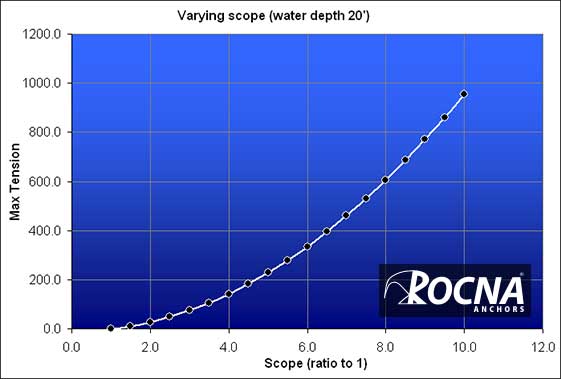
This graphs the deployed scope, i.e. increasing chain length, against the maximum tension required to introduce an upward force on the anchor (note that this is not necessarily the force required to actually drag the anchor; it is only an easily definable point to use for the purposes of these diagrams).
The greater the scope, the lower the maximum possible angle of pull on the anchor, by simple rules of trigonometry. However, beyond a certain point, increasing the scope makes very little difference.
If one studies the above chart, a prominent curve is evident out to about 8:1 scope. This is the quickly lowering angle of pull in action – the rate of increase of the tension is positive, meaning a factor in addition to the catenary is at work. Beyond this however, the scope has less increasing effect, and the only benefit is the linear one contributed by the chain’s catenary.
Additionally, deploying more than 10:1 scope is almost never practical, and more common ratios are around 5:1. Many boaters get by with 3:1 or less. In 5 meters of water, it is just not normally possible to anchor in such a way that a swinging circle of 50 meters radius is required. However, the more the scope can be maximized, the better. Up to about 8:1, the increases are very worthwhile.
Chain and Rope
The next consideration is that many boaters do not want to carry enough chain that would be necessitated by an effective scope, particularly in deep water. The simple solution is to make up the extra length with rope, which is of course far lighter. The contribution from rope to catenary is so small as to be discountable, so the amount of chain remaining in the rode is the sole contributor.
Below, for a fixed total rode length and fixed water depth (at a 6:1 ratio), it is shown how varying the relative amounts of chain and rope affects the maximum tension.
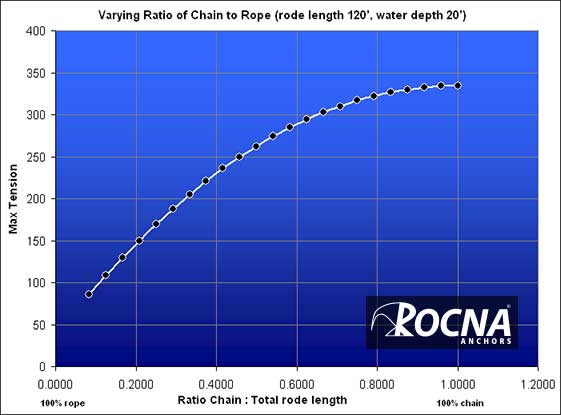
An interesting curve results, illustrating the fact that the benefit from the chain’s catenary in fact rapidly drops off past a certain length. In this example, increasing the chain past about 2/3 of the rode’s length seems hardly worthwhile. What would result in a 50% increase in weight provides only about a 10% increase in “max tension”.
The conclusion is that “all chain” is not particularly desirable in terms of performance, and a considerable amount of weight may be saved without detrimentally affecting the anchor.
Varying depth
In deeper water, clearly there is an increased amount of rode suspended in the water between the seabed and the boat. If the scope is kept constant by deploying more rode in deeper water, the effect of the catenary on “max tension” is obvious.
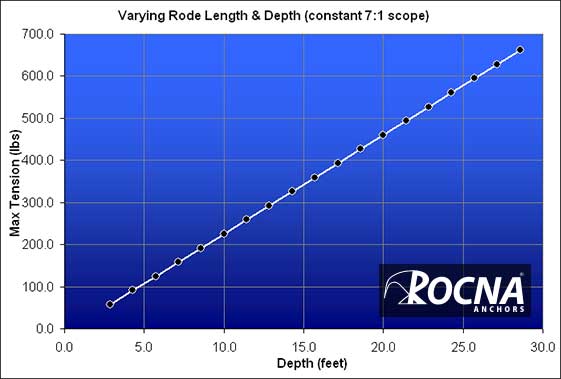
While this is a positive effect, it is not practical to deploy an amount of rode directly related to the depth of water. Such an amount could not practically be carried for very deep water, and along with depth, the swinging circle radius also increases. And, the reverse is also true: for very shallow water, the effect of catenary is reduced for a constant scope.
A more subtle story here is the relation again between scope (geometry) and catenary from chain for varying depths. In shallow water, scope needs to be increased because catenary does not help much. In deep water, the scope can be lessened because the catenary makes a little more impact (see below). This in turn has ramifications for the portion of chain and rope in the rode deployed, which was discussed above for a depth of 20′.
Above we looked at the varying ratio of rope to chain for a depth of 20′. Now compare that graph to the below, which is for the same scenario, only the depth is doubled to 40′:
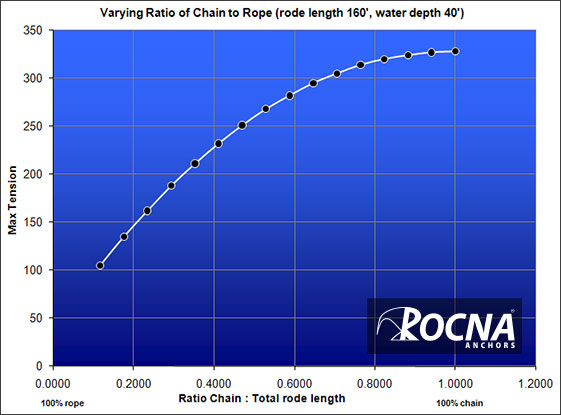
The benefit of the deeper water is seen in the fact that the rode has not had to also be doubled to retain a similar upper limit of “max tension”. On the contrary, instead of 6:1 scope, there is now a ratio of 4.25:1.
In the deeper water, the curve of the graph is slightly more pronounced and the initial benefits of the chain are less. While this might seem negative, it is only a relative measure. The conclusion is that there is now relatively more benefit from a higher portion of chain.
More on the reduced need for scope in deeper water
Deeper water does provide more of a role for catenary and a reduced need for a rigidly high scope ratio, as the below graph illustrates in a simple manner. However, while catenary begins to become more important, scope remains king.
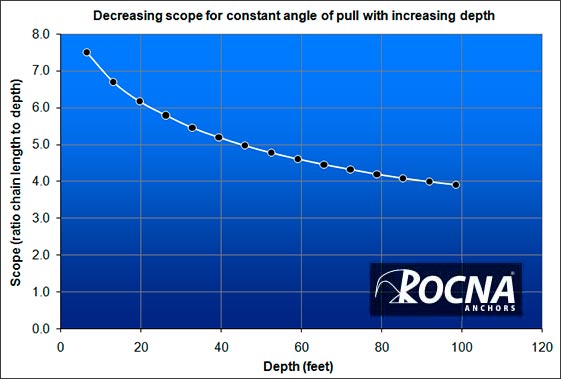
The above graph shows the situation for 5/16″ chain with 500 daN (1,124 lb-force) in the system, in the order of 40 knots wind on a 10 m / 33′ vessel. A constant angle of pull on the anchor of 6.6° is maintained for the same force.
It is important to note that while the graph falls steeply at first, the changes are not very significant. Even a tripling of depth means that scope may not be reduced much more than a little, if the anchor’s chances are not to be compromised. From 7′ to 100′ depth, the scope may only just be halved! Naturally this implies that in deep water, long rodes and increased swing radii are unavoidable.
Heavy chain
So far we have seen that a rode consisting of 100% chain is neither desirable nor necessary, looked over how several variables affect the picture, and concluded that greater scope is usually the best way to improve anchor performance. There is however one further consideration.
Real numbers have been used in the examples so far. With 5/16″ chain, the upper limits of the maximum tension has typically been between 300 and 400 lb-force. However, is this a realistic level of force? Is this a useful upper limit?
5/16″ chain might be best matched with a 35 lb (15 kg) anchor on a 35′ (10 m) boat. Now, such a boat might be expected to exert forces in line with the below graph:
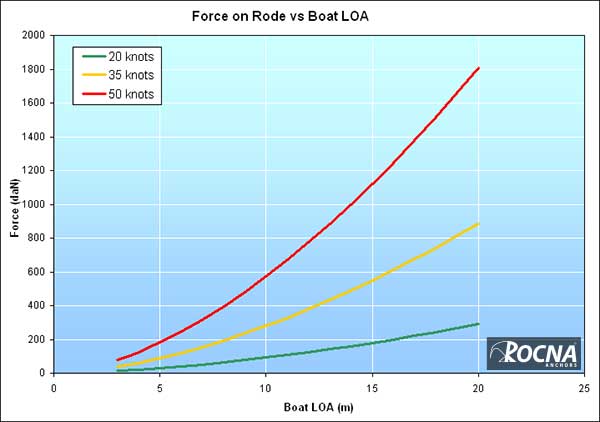
Note that the forces are measured now in deca-newtons, not lb-force. Our 10 m / 33′ boat in 50 knots wind is exerting nearly 600 daN (1,350 lb-force) on the anchor. Clearly this is far in excess of any of the “max tension” figures which have been seen so far. The pull angle on the anchor will inevitably have some vertical element.
Now consider that many anchors, particularly modern designs, are quite capable of holding far greater forces yet again. In the 2006 testing conduction by West Marine in association with SAIL magazine, the Rocna 15 (33 lb) held 4,800 lb-force at only 5:1 scope. The testers used 20′ of 5/16″ chain, the rest of the line 1″ nylon, in about 25″ of water, and reported the rode “bar tight”.
In other words, such an anchor will not be troubled by weather conditions which easily eliminate the contributions of catenary to the angle of pull on the anchor. The “window” in which catenary does have some benefit is well below the ultimate limits of the anchor’s capability.
A word on high tensile chain
While high tensile chain may be used, it pays to consider several of its characteristics. The nature of high tensile steel is such that its failure mode is very sudden, meaning that it tends to snap rather than stretching beforehand. The chain should therefore be a bit stronger than the BBB or G40 alternative, not of equal strength. Also, there are issues with high tensile chain and galvanizing – it should not be re-galvanized more than once or twice.
We might conclude that chain is entirely pointless, and 100% rope may be used. In theory there is some truth to this. However, chain is used with anchors for several other good reasons. These include abrasion resistance on the seabed and chaff resistance on the boat, the minimization of swinging circles in light conditions, and the dampening of a boat’s tendency to “sail” at anchor.
However, rather than use very heavy chain, it is reasonable to use lighter chain which still meets strength requirements. A considerable amount of weight can be saved by using high tensile chain as opposed to regular BBB, hi-test, or G40.
Aspects other than pure static physics
Aspects such as shock absorption have not been discussed in this article. The catenary from the chain is often assumed to be a good shock absorber, in addition to lowering the angle of pull on the anchor, as it takes some time to straighten. However, this is a fallacy, as this quasi “spring” disappears in bad conditions when it is most needed. A proper shock absorber is a nylon snubber or similar. On larger boats it may not be necessary in all conditions, while on smaller boats it is almost always advisable.
Another variable: boat size
At the beginning of this article, it was mentioned that a large ship is ideally anchored differently to a toy boat. The discussions above have focused around the reality for a boat of approximately 10 meters length. The larger the boat, the more focus does need to be placed on the rode, particularly chain. Conversely, the smaller the boat, the more focus needs to go on the anchor (and providing good shock absorption).
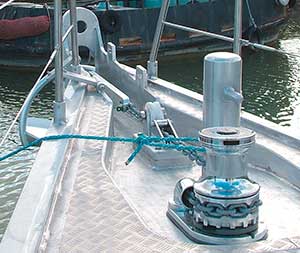
Summary
The most important conclusion emphasizes the importance of scope. If the graphs above are studied, it is obvious that the benefit of catenary is mostly lost in strong winds, with the exception of very deep water, and since the anchor is probably quite capable of holding given an adequate angle of pull, the sole remaining thing you can do to help the anchor is veer more rode.
If you want to increase the potential holding power of your system for the same scope, then the answer is to put the focus back on the anchor. If you have adequate scope deployed yet your anchor tends to drag, consider upgrading to a superior modern design. At the same time you could also increase the size of the anchor. Taking a few kilograms of weight out of the chain and putting it into the anchor results in a significant increase in holding power.
